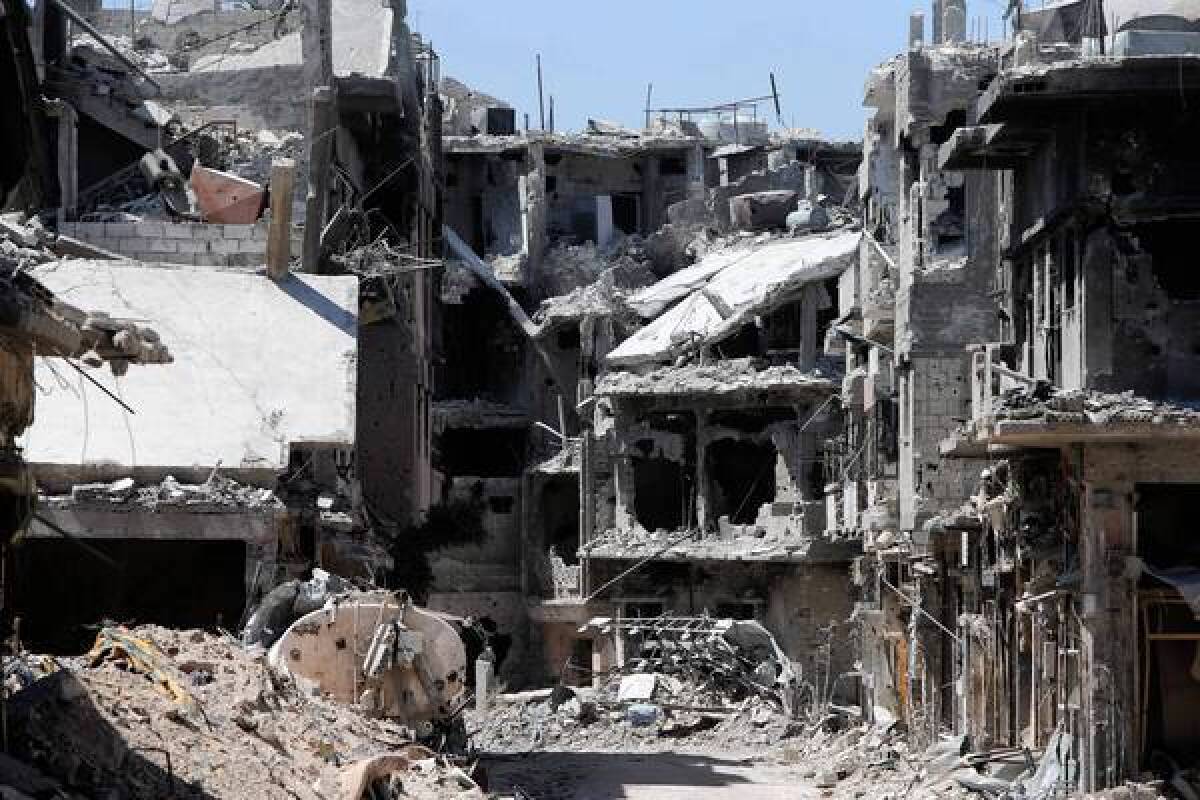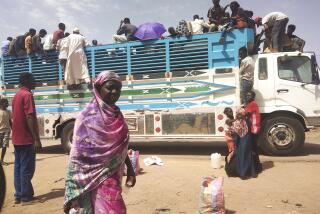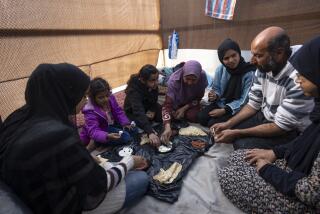Syrians seek shelter in a city of rubble

HOMS, Syria — The voices of children emanate from the orderly confines of the Martyr Mohammad Hawa School. Some youths tend to cornstalks in a makeshift garden. A veiled mother lingers in the front doorway with her young daughter. As the midday heat subsides, there’s a noticeable burst of energy on the streets outside.
But it’s not children leaving class for the day. The kids working the garden are living at the school. The mother and child are desperate for help. Some extra food? A place to stay?
The school is no longer an institution of learning. It’s a citadel of survival. For almost 18 months, its classrooms have provided shelter to about 300 people, mostly women and children, left homeless by the civil war raging in Syria, and specifically in this city, which went from obscurity to global infamy two years ago as the epicenter of the rebellion against President Bashar Assad.
“We just want to go back to our homes,” says Amira, a grandmother who lives with her extended family in one of the elementary school classrooms, and, like many others here, preferred to be identified by her first name for security reasons.
Everyone wants to go home. Left unspoken is the disquieting reality that few here have homes to return to. If anything, things will get worse long before they get better.
The U.S. is now debating military strikes to punish Assad for his alleged use of chemical weapons. Rebel forces say they intend to launch attacks across the country to try to change the tide of war in a country where the United Nations says 1 in 4 people already have been driven from their homes.
More than 2 million Syrians have left the country; an additional 4 million displaced people remain, a sizable number living in schools, half-completed apartment blocks, abandoned buildings, makeshift shelters or with relatives.
Most staying at this school are from Homs’ Old City, once this provincial capital’s bustling core, now a rubble-strewn battleground where pro-government forces have been advancing relentlessly against entrenched and encircled rebels.
Several thousand civilians reportedly remain trapped in the Old City — too fearful of the Syrian army and allied militias to leave, according to the rebels, or, in the government’s telling, as human shields.
As is often the case in Syria’s war zones, each side sticks to its version as an article of faith.
Meanwhile, gunfire crackles, explosions detonate and smoke rises with regularity from the tightly packed warren of alleys and streets of the Old City, which encompasses more than half a dozen distinct neighborhoods, all now situated on a continuum between heavily damaged and flattened.
Syrian soldiers positioned on their side of a no man’s land point to corners and landmarks ruled by unseen snipers hunkered down somewhere behind blown out windows of bullet-pocked buildings.
“They fire at us, we fire back at them,” says an elderly pro-government militiaman in the Lion’s Gate district, largely recaptured by government forces and their allies in recent months.
Another government militiaman, Bassam, hops off his motorbike to lead several visiting journalists on a tour of the mostly abandoned streets, occasionally marked by a burned-out vehicle or the shell of an armored personnel carrier.
“People think I’m a Muslim because of this,” says Bassam, a former fine arts student in his 20s, stroking his thick black beard. “Actually, I’m a Christian.”
The sectarian dimension of the conflict seldom recedes here. Sunni Muslims, the majority in Homs, have long chafed at the rule of the Assad family, members of the minority Alawite sect. Christians and other minorities tend to side with the government against what they view as an onslaught of Sunni Muslim fundamentalists and Al Qaeda-linked foreign fanatics. Graffiti on walls in Lion’s Gate carries the signature of “Abu Ghazwan, the Libyan” and other rebel personages who passed through, leaving behind scrawled traces of their jihad odyssey.
“We are the sons of the area,” proclaims the pro-government Bassam. “We can rebuild it.”
The overriding impression of Homs after a pair of visits is that of a community of more than 1 million in collective shock, though the war has hit unevenly.
In Zahara, a mostly Alawite district, the main drag, Share Hadharah, or Civilization Street, buzzes with cafes and eateries that continue to cater to families and students from the nearby university. Soldiers posted every few blocks puff on cigarettes and sip mate tea from metal straws, appearing at ease.
In some other districts here, the damage has an almost hallucinatory character. There’s a haunting quality to the rows of abandoned and shot-up shops along Droubi Street, once a lively downtown commercial strip. Absent pedestrians and businesses, the thoroughfare is forlorn and disturbing, with tanks and armored vehicles sitting where shoppers once parked their cars.
A second-floor office in a commercial mall houses a firm called the Syrian Islamic Insurance Co. There’s nobody inside, but old policies and other paperwork litter the floor.
Then there’s the ghostly vibe of Bab Amr, once the heart of the uprising here, now a desolate expanse where few buildings along the main drag appear to have escaped damage. The military now controls entry to Bab Amr, keen to ensure the rebels who ran the area for more than a year do not return.
In a surreal moment, an elderly bicyclist pedals serenely down Bab Amr’s eerily quiet main street, obliterated buildings on both sides of his path, as though he were cruising down a country lane. He says he’s on his way to tend cows in a pasture outside town. This, he says, is the most direct route, no longer a treacherous passage through a war zone.
“Whoever did this to us has no religion,” says the bicyclist.
The rubble-ization of Homs has altered vistas in odd ways. From some streets near the Old City, the involuntary demolition has cleared long-obscured views of the city’s signature religious landmark, the majestic Khalid bin Walid mosque, named after a companion of the prophet, the guardian of Homs, it is said.
The mosque’s sleek minarets and silver-domed cupolas show some signs of damage but remain intact, vaulting into the sky above the ruins, a phoenix rising amid the desolation. Before the war, Homs was known for two things — its desert winds and its mosques.
The Martyr Mohammad Hawa School is in the middle-class Inshaat district that has largely stayed out of the conflict. A nearby barbecue place does brisk business; patrons inside watch the passing street life and soak up a sense of relative normality. The jovial owner says he opened the place after his previous job, importing clothes from Turkey, disappeared with the war. People always have to eat, he says. Business is brisk.
Of six schools in Inshaat, only one still serves its intended purpose. The rest have become shelters for the displaced.
Numerous schools have been destroyed or commandeered by armed factions. At functioning schools, many students must cope with classes of 70 or 80 — or remain home. It’s one of the collateral effects of the war — not nearly as dramatic as massive bombardments, but a legacy that has already scarred a generation.
In the coastal city of Latakia, thousands are housed in a rambling stadium and sports complex along the Mediterranean named after Hafez Assad, the president’s late father. Some sleep in dormitories inside the stadium, hanging their clothes to dry on makeshift clotheslines in the stands. Others have pitched tents in the parking lot outside.
Generally the multitudes of displaced in the government-controlled parts of Syria aren’t overtly visible. There are no sprawling refugee camps, like those housing Syrians who have fled to neighboring Turkey, Jordan and Iraq.
Many families have opened up their homes to those lacking shelter. Others donate food and other necessities. Here in Homs, despite all that has happened, there still seems to be a sense of solidarity with fellow Syrians who are suffering.
“These are our people,” says Labib Abdul Dayem, 55, an out-of-work engineer who, along with other professionals and craftsmen, has donated his time to improving the shelter in the Martyr Mohammad Hawa School. “At least they are in their country, not outside in a foreign land somewhere in a refugee camp.”
Although the U.N. and other organizations provide aid, the school also relies heavily on donations from residents of all sects. One Christian businessman provides frozen chickens from his plant, to be cooked in the communal kitchen.
Many of the shelter’s absent menfolk are probably in the rebel ranks, or have died fighting the government. But no one wants to talk of such matters.
Inside, the living quarters are neat and organized despite the confined space. Volunteers have thrown up sheet-rock walls to divide classrooms into living spaces, while also constructing shower areas and other essential space. Sixty-two families live here, most of them long-term.
“There is a war going on, but no one in Homs sleeps on the streets,” says Dayem, and it appears to be true. “There is a place for everyone.”
Times staff writer McDonnell was recently on assignment in Homs. Special correspondent Nabih Bulos contributed to this report.
More to Read
Start your day right
Sign up for Essential California for news, features and recommendations from the L.A. Times and beyond in your inbox six days a week.
You may occasionally receive promotional content from the Los Angeles Times.






